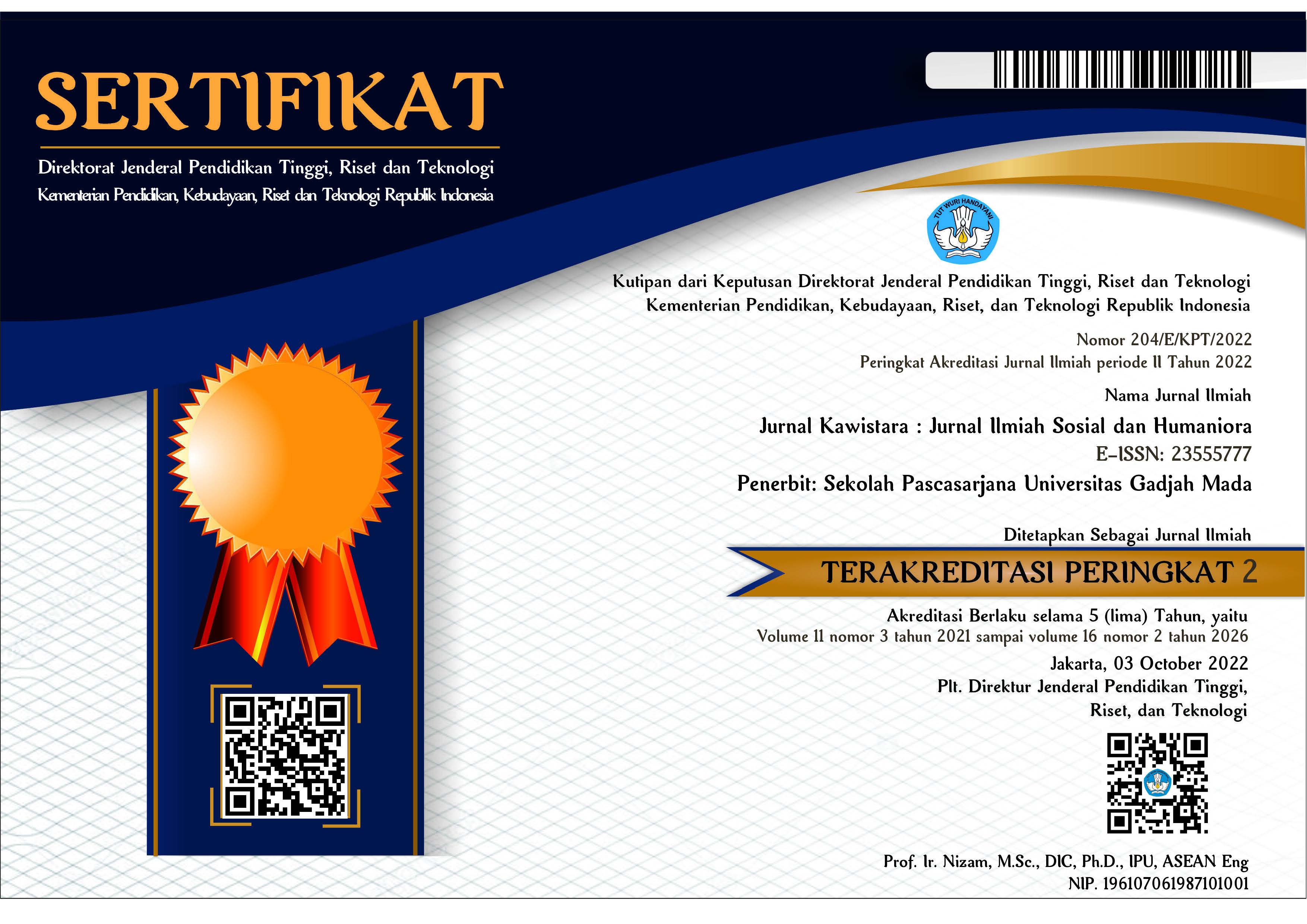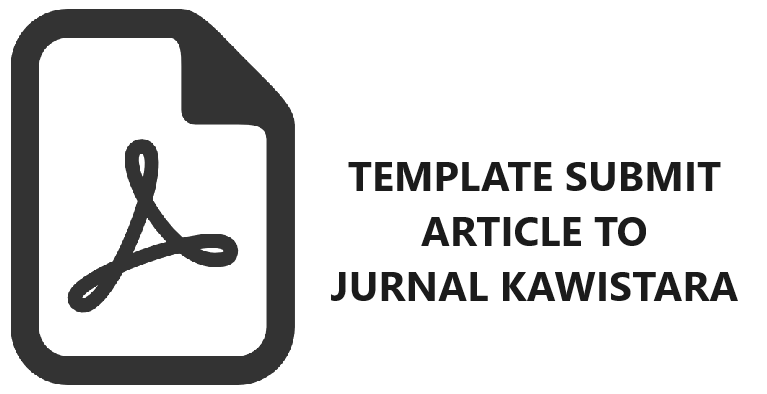PRODUKSI BUDAYA DALAM WEDDING PLANNER PADA MASYARAKAT URBAN
Risky Chairani Putri(1*), Wiwik Sushartami(2)
(1) Gadjah Mada University
(2) Gadjah Mada University
(*) Corresponding Author
Abstract
Keywords
Full Text:
PDFReferences
Alsaawi, A. (2014). A Critical Review of Qualitative Interviews. European Journal of Business and Social Sciences, 3(4):149–156.
Ardiyanto, W. (2017). Potensi dan Perkembangan Surabaya Makin Mengejar Jakarta. Diakses pada tanggal 29 Maret 2018. Dapat diakses di https://www.rumah.com/berita-properti/2017/12/166706/potensi-danperkembangan-surabaya-makin-mengejar-jakarta/.
Bank, M. dan O’connor, J. (2009). After the Creative Industries. International Journal of Cultural Policy, 15(4):365–373.
Blakely, K. (2007). Busy Brides and the Business of Family Life. Journal of Family Issues, 29(5):639–662. doi: 10.1177/0192513x07309453.
Bourdieu, P. (1993). The Field of Cultural Production, New York: Columbia University Press.
Caves, R. E. (2000). Creative Industries, Cambridge, MA: Harvard Univ. Press.
Chanan, M. (1995). Repeated Takes: A Short History of Recording and Its Effects on Music, London: Verso.
CITF (Creative Industries Task Force). (2001). Diakses pada tanggal 29 September 2018. Dapat diakses di www.culture.gov.uk/creative/mapping.html.
Coser, L. A., Kadushin, C., and Powell, W. W. (1982). Books:The Culture and Commerce of Publishing, Chicago, IL: Univ. Chicago Press.
Crane, D. (1997). Globalization, Organization Size, and Innovation in The French Luxury Fashion Industry: Production of Culture Theiry Revised. Poetics, 24:393–414.
Cunninggham, S. (2002). From Cultural to Creative Industries: Theory, Industry and Policy Implications. Media International Australia Incorporating Culture and Policy, 101(1):54–65.
Daniswara, F., Hermanadi, H. dan Rizal, N. (2016). Young Microselebrities in Indonesia. Yogyakarta.
Debord, G. (2005) Society of The Spectacle, London: Rebel Press.
DiMaggio, P. and Powell, W. (1991). The New Institutionalism in Organizational Analysis, Chicago, IL: Universitas Chicago Press.
Evans, S. (2013). Become an Event Planner: Careers in event planning. Become an Event Planner: The Three Necessary Steps to Begin Your Event Planning Career [online]. Diakses pada tanggal 25 Agustus 2017. Dapat diakses di https://www.careers-in-event-planning.com/support-files/shortreporthowtobecomeaneventplanner.pdf
Evetts, J. (2014). The Concept of Professionalism: Professional Work, Professional Practice and Learning. International Handbook of Reserach in Professional and Practice-Based Learning. doi: 10.1007/978-94-017-8902-8_2.
Fahmi, F. Z., McCann, P., dan Koster, S. (2017). Creative Economy Policy in Developing Countries’, Urban Studies, 54(6):1367–1384.
Featherstone, M. (2007). Consumer Culture and Postmodernism. London: SAGE Publication.
Fine, G. (1992). The Culture of Production. Am. J. Sociol, 97:1268–1294.
Foucault, M. (1972) The Archaelogy of Knowledge and The Discourse on Language (Terjemahan dari B. Prancis oleh A. M. Sheridan Smith), New York: Pantheon Books.
Handayani, O. (2016). Perlindungan Hukum Terhadap Perusahaan Jasa Penyelenggara Kegiatan dan Pengguna Jasa dalam Perikatan Penggunaan Jasa. Tesis. Yogyakarta: Universitas Gadjah Mada.
Hesmondhalgh, D. (2007) The Cultural Industries. 2nd ed, London: SAGE Publication.
Johnson, R. J. (2005). The Wedding Ceremony Planner: The Essential Guide to The Most Important, Illiniois: Sourcebooks, Inc.
Khotari, C. (2004). Research Methodology Methods and Techniques. 2nd ed, New Delhi: New Age International.
Landsverk, K. (2014). The Instagram Handbook. 1st ed, London: PrimeHead Limited.
Liley, K. (2003). Review of the book The Cultural Industries, by David Hesmondhalgh, Journal of Sociology, 41(2): 218–220.
Markusen, A., Wassall, G.H., DeNatale, D., dan Cohen, R. (2008). Defining the Creative Economy: Industry and Occupational Approaches, Economic Development, 22(1):24–45.
Menger, P-M. (1999). Artistic Labor Markets and Careers. Annual Review of Sociology, 24:541–571.
Miege, B. (1989). The Capitalization of Cultural Production, New York: International General.
Mosco, V. (2009) The Political Economy of Communication. 2nd ed, London: SAGE.
Nations, U. (2004) Creative Industries and Development. Sao Paulo: United Nations.
Pemerintah Republik Indonesia. (2012). Peraturan Daerah Kota Surabaya Nomor 23 Tahun 2012 Tentang Kepariwisataan. Surabaya: Walikota Surabaya.
Pemerintah Republik Indonesia, (2014) UU Nomor 28 tahun 2014 tentang Hak Cipta. Jakarta: Presiden Republik Indonesia dan Dewan Perwakilan Rakyat Republik Indonesia.
Pemerintah Republik Indonesia (2015) Peraturan Presiden Nomor 6 Tahun 2015. Jakarta: Presiden Republik Indonesia.
Peterson, R. A. dan Anand, N. (2004). The Production of Culture Perspective. Annual Review of Sociology, 30:311–334. doi: 10.4135/9781412939645.n83.
Peterson, R. A. and Berger, D. G. (1971). Entrepreneurship in Organizations: Evidence from the Popular Music Industry. Admin. Sci. Q, 16: 97–106.
Ratna, N. K. (2010). Metodologi Penelitian Kajian Budaya dan Ilmu Sosial Humaniora pada Umumnya, Yogyakarta: Pustaka Pelajar.
Schmutz, V. and Miller, C. N. (2015). Production of Culture, dalam Scott, R. dan Kosslyn, S. (eds) Emerging Trends in The Social and Behavioral Sciences, Canada: John Wiley & Sons, Inc.
Scott, A. J. (2006). Creative Cities: Conceptual Issues dan Policy Questions. International Journal of Urban and Regional Research, 21(2):323–339.
Setiani, I. (2015). Laporan Tugas Akhir Sistem Informasi Pemesanan Paket Pernikahan pada Bellayanis Wedding Organizer. Skripsi. Yogyakarta: Universitas Gadjah Mada.
Sparks, C (2004). The Impact of the Internet on The Existing media. Dalam Andrew Calabrese dan Colin Sparks (eds). Towards a Political Economy of Culture, Lanham, MD: Rowman & Littlefield, pp. 307–326.
Strinati, D. (2004). An Introduction to Theories of Popular Culture, London: Routledge.
Suseno, I. K. (2009). Untung BesarBisnis Event Organizer, Yogyakarta: Penerbit Indonesia Cerdas.
Thompson, E. (2002). The Soundscape of Modernity: Architectural Acoustics and The Culture of Listening in AmeriCa 1990-1933, Cambridge, MA: MIT Press.
Tunstall, J. (2001) Media Occupations and Professions: A Reader, London: Oxford University Press.
Wedding Vendor. Diakses pada tanggal 24 Maret 2018. Dapat diakses di https://www.weddingku.com/
White, H. (1981). Canvases and Careers: Institutional Change in the French Painting World. New York, Am. J. Sociol, 87:517–547.
Williams, R. (1981). Culture. London: Fontana.
Sumber Wawancara
Dwi Wijayanto. 5 April 2018. Pemilik Mahar Agung Organizer
Gama Mahardika. 7 September 2018. Manajer Operasional Mahar Agung Organizer.
Sri Fuji Rahayu. 27 Februari 2018. Pemilik Atmanandhi Wedding Organizer.
Article Metrics
Refbacks
- There are currently no refbacks.
Copyright (c) 2020 Risky Chairani Putri

This work is licensed under a Creative Commons Attribution-ShareAlike 4.0 International License.
Jurnal Kawistara is published by the Graduate School, Universitas Gadjah Mada.











